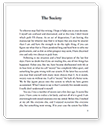Essay Instructions: Topic: Bipolar Disorder: How Bipolar Disorder effects the routine life of a person in Work, Family, Friends.
Thesis Statement to be used: "Bipolar disorder is an intricate physiological and psychological disorder that can control, tamper, and falsify a person's thoughts and actions in their daily life."
Directions: You must include at least 10 relevant journal articles in your paper. All articles must be empirical* and recent (written within the last 5 years unless the citation is linked to an author whose work is seminal to your topic). This paper should be written in a scholarly fashion, strictly adhering to APA standards. Do not express your own opinion.
You should use the following guidelines in constructing your research paper:
• Abstract page.
• Introduction should define and discuss the importance of your topic.
• The body of the paper should organize the topic in a meaningful way and critically review the current empirical knowledge base relevant to your topic.
• A conclusion section should include a discussion of practice/policy implications/recommendations and future research directions.
• Reference page should list at least 10 primary empirical sources.
• Follow APA Publication Manual organization and style guidelines
Direction Cont':
1. Do not use personal pronouns or your opinions in your research paper. (I, you, they, we, your, etc).
2. Do not use your opinions in the research paper.
3. Do not use contractions.
4. Do not overuse a word, even if it’s the topic!
5. Do not use footnotes.
6. Do not end a sentence with a preposition.
7. Do not use casual terms, such as “kids,” “a lot of.”
8. Do not use too many quotes or too long a quote; I want your ideas!
10. Regarding numbers: 1 ??" 10, use numerals; 10+ use words.
11. Avoid using strong verbs, such as, proves, causes, determines. Try something like, “suggest.”
12. Use correct punctuation. Quotation marks are outside commas and periods. Use commas around “however” and “therefore.
13. Use correct noun/pronoun agreement:
Person---who (not that)
Persons----they (incorrect)
13. Avoid “he/she” by using the plural: people/they
Sentence Structure
14. Do not submit “run on, wordy sentences.”
15. If you submit a “group of words” that is not a sentence, you will
lose 10 points.
16. Effect/Affect
These words can be confusing; which to use?
Affect: is a VERB; to influence (The drug affected the disease.)
Effect: anything brought about by an agent; a result; (The drug had a positive effect on the disease.)
17. References in the reference list MUST be cited in the paper.
18. References cited in the paper MUST be listed in the reference section.
19. Do not submit your annotated bibliography as your reference list; check APA .
20. Use academic journals and one or two books may be used if critical to the paper.
21. Use correct APA style.
References to be used:
Lichtenstein, P., Yip, B., Björk, C., Pawitan, Y., Cannon, T., Sullivan, P. & Hultman. C. (2009). Common genetic determinants of schizophrenia and bipolar disorder in Swedish families: a population-based study. The Lancet, 373(9659), 234-39.
Merikangas, R., Akiskal, H., Angst, J., Greenberg, P., Hirschfield, R., Petukhova, M. & Kessler, D. (2007). Lifetime and 12-Month Prevalence of Bipolar Spectrum Disorder in the National Comorbidity Survey Replication. Archives of General Psychiatry 64(5), 543-52.
Miklowitz, D. (2007). The Role of the Family in the Course and Treatment of Bipolar Disorder. Current Directions in Psychological Science, 16(4), 192-6.
Miller, I., Keitner, G., Ryan, C., Uebelacker, L., Johnson, S. & Solomon, D. (2008). Family Treatment for Bipolar Disorder: Family Impairment by Treatment Interactions. Journal of Clinical Psychiatry, 69(5), 732-40.
Moreno, C., Laje, G., Blanco, C., Jiang, H., Schmidt, A. & Olfson, M. (2007). National Trends in the Outpatient Diagnosis and Treatment of Bipolar Disorder in Youth. Archives of general psychiatry, 64(9), 1032-9.
Muller, D., de Luca, V., Sicard, T., King, N., Strauss, J. & Kennedy, J. (2006). Brain-derived neurotrophic factor (BDNF) gene and rapid-cycling bipolar disorder. The British Journal of Psychiatry, 189, 317-23.
Pandey, G., Rizavi, H., Dwivedi, Y. & Pavuluri, M. (2008). Brain-Derived Neurotrophic Factor Gene Expression in Pediatric Bipolar Disorder: Effects of Treatment and Clinical Response. Child & Adolescent Psychiatry 47(9), 1077-85.
Phillips, M., Travis, M., Fagioloni, A. & Kupfer, D. (2008). Medication Effects in Neuroimaging Studies of Bipolar Disorder. American Journal of Psychiatry 165, 313-20.
Post, R. & Leverich, G. (2007). The Role of Psychosocial Stress in the Onset and Progression of Bipolar Disorder and its Comorbidities: The Need for Earlier and Alternative Modes of Therapeutic Intervention. Focus 5, 73-97.
Strakowski, S., DelBello, M., Fleck, D., Adler, C., Anthenelli, R., Keck, P., Arnold, L. & Amicone, J. (2007). Effects of Co-occurring Cannabis Use Disorders on the Course of Bipolar Disorder After a First Hospitalization for Mania. Archives of General Psychiatry, 64(1), 57-64.
Customer is requesting that (FreelanceWriter) completes this order.


